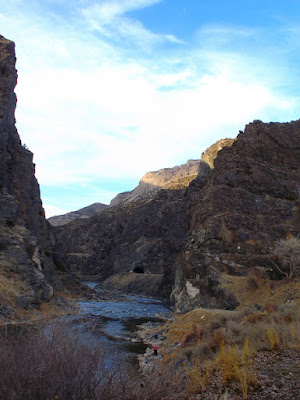Looking north (below) is the southernmost tunnel, and just about 100 yards south beyond it is Boysen State Park. If you want a satellite view, click here.
SITE OF ORIGINAL BOYSEN DAMMule teams hauled the materials for the original Boysen Dam, built here in the early 1900s by Asmus Boysen to provide power for his gold and copper mining interests in this area. A few years later when the Burlington Railroad built through the Wind River Canyon, rising water behind the dam was declared to be a menace to the operation of the railroad. The railroad sued Boysen, who argued unsuccessfully that the tracks could be raised. He lost the suit and was ordered to remove the superstructure of the dam. Another dam farther upstream replaced the original Boysen Dam, the last of which was torn down in 1948, although the abutments of the old dam may still be seen here. Asmus Boysen was a Danish immigrant who had risen to a position of wealth and political prominence in Iowa. He lost his fortune in this venture. He died in 1938.

 The photographs of the park above (looking south) and below (looking north) are taken from the same location.
The photographs of the park above (looking south) and below (looking north) are taken from the same location. In the center of the shot above is the middle tunnel. The stairway below is found on the left cliff above.
In the center of the shot above is the middle tunnel. The stairway below is found on the left cliff above.BOYSEN'S HISTORIC DAMIn the early 1900s, Asmus Boysen, a Danish immigrant and successful businessman, dreamt of building a dam that would provide water and power to Central Wyoming. The dam was to be an engineering achievement, spanning 180 feet high and 124 feet long, with a lake 14 miles long and 2 1/2 miles wide. The power plant was unique with five turbines generating electricity to nearby mining camps and to Shoshoni and Riverton.Boysen's dream was short-lived as a series of flash floods deposited tons of silt and sand causing the turbines to shut down. Water rose behind the silt-filled dam and threatened the nearby railroad tracks. To prevent more flooding, Boysen blasted away part of the dam. But over the years, flooding continued to damage the dam until 1948 when the Bureau of Reclamation completely removed it.Today, silt-deposits from the original dam provide the sites of both the upper and lower Wind River campgrounds.


 North of the three tunnels the road curves back and forth as it follows the river. The tunnel in the center is for the railroad.
North of the three tunnels the road curves back and forth as it follows the river. The tunnel in the center is for the railroad.link: index to photographs














No comments:
Post a Comment